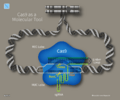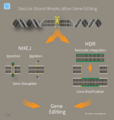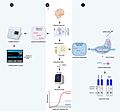CRISPR facts for kids

CRISPR is a special term used in the study of tiny living things, called microbiology. It stands for Clustered Regularly-Interspaced Short Palindromic Repeats. This is a natural part of the genetic code found in very simple living things. Most bacteria and archaea have it.
CRISPR has many short, repeated sequences. These sequences are part of a defense system for these tiny organisms. It helps them remember and fight off other organisms that try to harm them. This includes tiny viruses called bacteriophages.
Scientists have learned how to use CRISPR. It can change the genes of almost any living thing. It is a tool that allows very exact cutting and adding of genes. This is used in genetic modification. Researchers are also studying how CRISPR can fight virus diseases in humans. This is called gene therapy.
How CRISPR Works
Imagine CRISPR as a tiny memory bank for bacteria. Each repeated part of CRISPR is followed by a short piece of "spacer DNA." These spacers are like tiny trophies from past battles. They come from viruses or other invaders that tried to attack the bacteria before.
When a known invader tries to attack again, the CRISPR system recognizes it. The spacers act like a "most wanted" poster for the invader's genetic material. This system helps bacteria protect themselves. It's like an immune system for bacteria.
A special protein called Cas9 does the actual cutting. Cas9 is a nuclease, which means it can cut DNA. It has two cutting sites. These sites cut both sides of the invader's DNA. Cas9 unwinds the foreign DNA. It then checks if it matches the spacer part of its guide RNA. If it matches, the foreign DNA gets chopped up. This stops the invader from causing harm.
Amazing Uses of CRISPR
CRISPR technology is very powerful. Scientists have used it to turn off genes in human cells. This helps them study how cells work. It has also been used to study a type of fungus called Candida albicans.
CRISPR can also change yeasts. These modified yeasts can then be used to make biofuel. It is also used to change crop plants. This can make crops stronger or grow better.
Scientists are exploring many more uses for CRISPR. It has the potential to help with many diseases.
Images for kids
See also
 In Spanish: CRISPR para niños
In Spanish: CRISPR para niños








